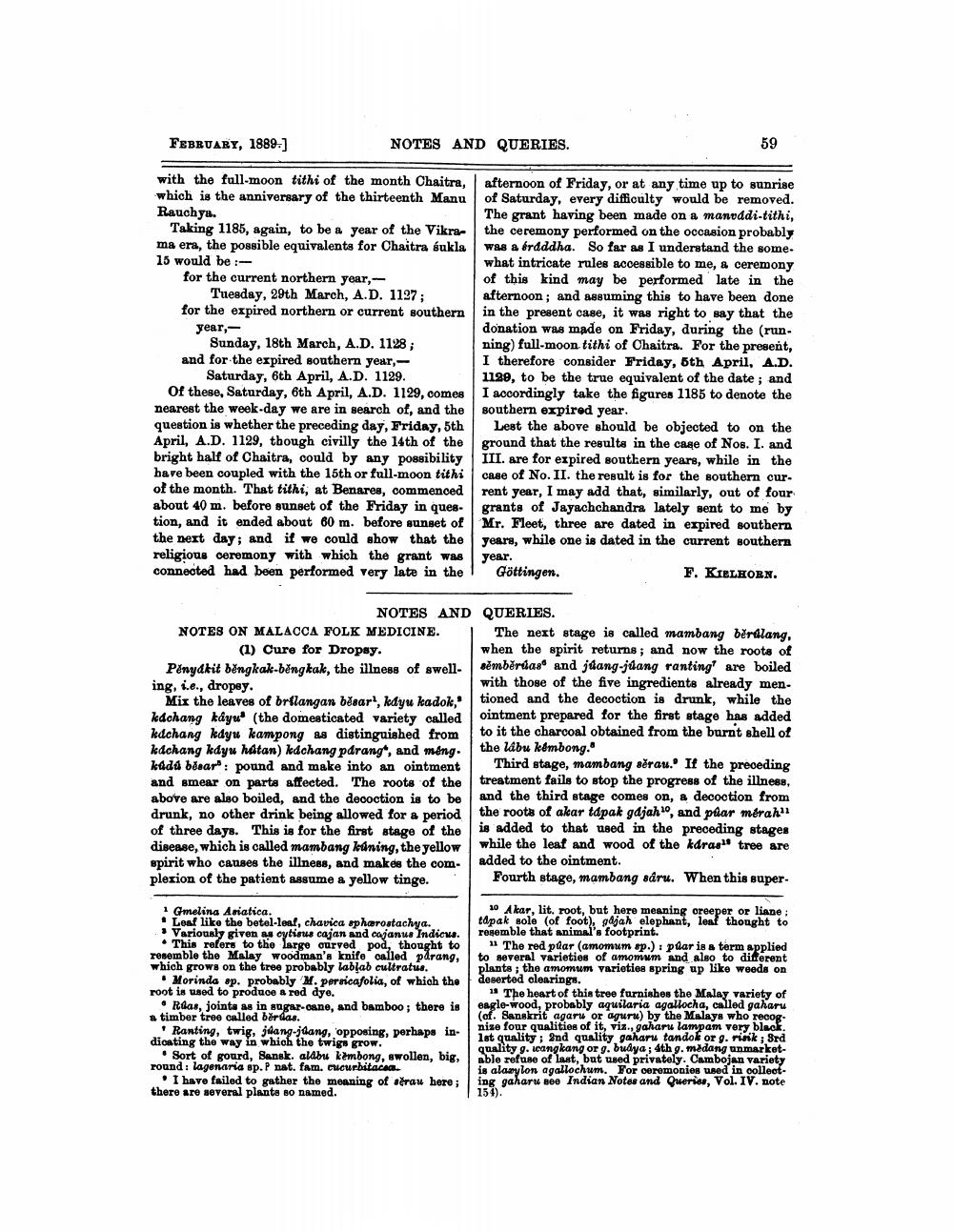________________
FEBRUARY, 1889.)
NOTES AND QUERIES.
59
with the full-moon tithi of the month Chaitra, which is the anniversary of the thirteenth Manu Rauchya.
Taking 1185, again, to be a year of the Vikram ma era, the possible equivalents for Chaitra sukla 15 would be :for the current northern year,
Tuesday, 29th March, A.D. 1127; for the expired northern or current southern year,
Sunday, 18th March, A.D. 1128; and for the expired southern year,
Saturday, 6th April, A.D. 1129. Of these, Saturday, 6th April, A.D. 1129, comes nearest the week-day we are in search of, and the question is whether the preceding day, Friday, 5th April, A.D. 1129, though civilly the 14th of the bright half of Chaitra, could by any possibility have been coupled with the 15th or full-moon tithi of the month. That tithi, at Benares, commenced about 40 m. before sunset of the Friday in question, and it ended about 60 m. before sunset of the next day, and if we could show that the religious ceremony with which the grant was connected had been performed very late in the
afternoon of Friday, or at any time up to sunrise of Saturday, every difficulty would be removed. The grant having been made on a manuddi-tithi, the ceremony performed on the occasion probably was a brdddha. So far as I understand the some. what intricate rules accessible to me, a ceremony of this kind may be performed late in the afternoon; and assuming this to have been done in the present case, it was right to say that the donation was made on Friday, during the (run. ning) full-moon tithi of Chaitra. For the present, I therefore consider Friday, 5th April, A.D. 1129, to be the true equivalent of the date; and I accordingly take the figures 1185 to denote the southern expired year.
Lest the above should be objected to on the ground that the results in the case of Nos. I. and III. are for expired southern years, while in the case of No. II. the result is for the southern cur. rent year, I may add that, similarly, out of four grants of Jayachchandra lately sent to me by Mr. Fleet, three are dated in expired southern years, while one is dated in the current southern year. Göttingen.
F. KIELKORN.
NOTES AND QUERIES. NOTES ON MALACCA FOLK MEDICINE. The next stage is called mambang berdlang, (1) Cure for Dropsy.
when the spirit returns; and now the roots of Penyakit bengkak-bongkak, the illness of swell- němbërtas' and júang-júang ranting' are boiled ing, i.e., dropsy.
with those of the five ingredients already men. Mix the leaves of brilangan bosar!, kdyu kadok, tioned and the decoction is drunk, while the kdchang kayu (the domesticated variety called ointment prepared for the first stage has added kdchang kdyu kampong as distinguished from
to it the charcoal obtained from the burnt shell of kdchang kdyu hatan) kdchang pdrang, and mång.
the lábu kémbong. kada bisar): pound and make into an ointment
Third stage, mambang sěrau. If the preceding and smear on parts affected. The roots of the treatment fails to stop the progress of the illness, above are also boiled, and the decoction is to be
and the third stage comes on, a decoction from drunk, no other drink being allowed for a period the roots of akar tapak gdjah, and paar merah of three days. This is for the first stage of the
is added to that used in the preceding stages disease, which is called mambang kuning, the yellow while the leaf and wood of the kdras tree are spirit who causes the illness, and makes the com
added to the ointment. plexion of the patient assume a yellow tinge. Fourth stage, mambang sdru. When this super.
1 Gmelina Asiatica. • Leaf like the betel-leat, chavica sphørostachya. . Variously given a cytinus cajan and cajanus Indicua.
• This refers to the large curved pod, thought to resemble the Malay woodman's knife called parang, which grows on the tree probably labļab cultratus.
Morinda sp. probably M. persicafolia, of which the root is used to produce a red dye.
• Rdas, joints as in sugar-oane, and bamboo; there is a timber tree called borsas.
Ranting, twig, juang-jdang, opposing, perhaps in dicating the way in which the twigs grow.
• Sort of gourd, Sanak. aldbu kembong, swollen, big, round: lagenaria sp.P nat. fam. cucurbitacea.
I have failed to gather the meaning of drau here; there are several plants so named.
20 Akar, lit. root, but here meaning oreeper or liane : tapak sole (of foot), gajah elephant, loul thought to resemble that animal's footprint.
11 The red púar (amomum sp.) . paar is a term applied to several varieties of amomum and also to different plants; the amomum varieties spring up like weeds on deserted clearings.
The heart of this tree furnishes the Malay variety of eagle-wood, probably aquilaria agallocha, called gaharu (of. Sanskrit agaru or aguru) by the Malays who recog. nize four qualities of it, viz., gaharu lampam very black. 1st quality: End quality gaharu tandok or g. risik Srd quality g. cangkang or g. budya; 4th . midang unmarketable refuse of last, but used privately. Cambojan variety is alamylon agallochum. For ceremonies used in collecting gaharu soo Indian Notes and Querie, Vol. IV. note 154).




